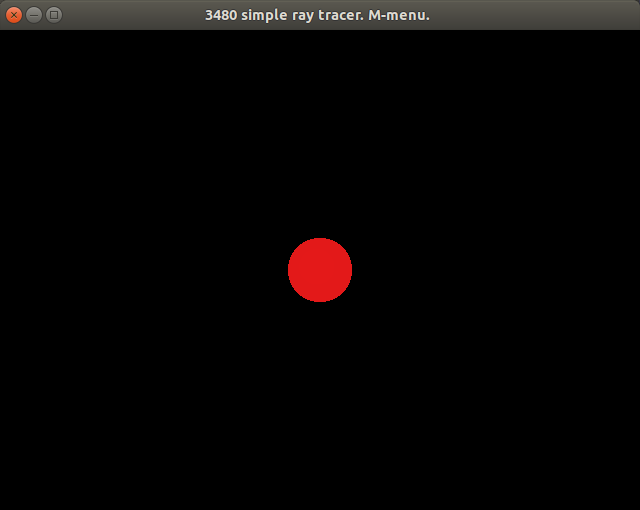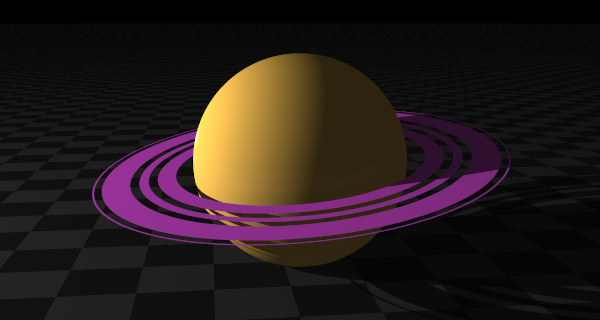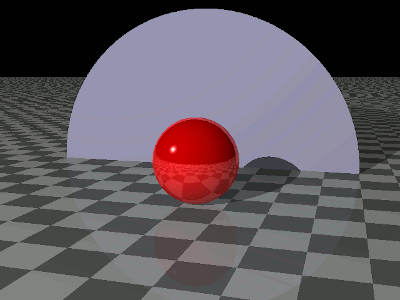Step 1:
Change to your 3480/8/ folder.
Copy the lab files now...
cp /home/fac/gordon/p/3480/code/lab8/* .
Compile and run the program:
make
./lab8
Pressing R renders a disk.
 If you see this image, your program is working.
We will do some coding together to make an incredible scene.
Get ready to code!
If you see this image, your program is working.
We will do some coding together to make an incredible scene.
Get ready to code!
Homework
Homework is...
Choose #1 or #2
1. Create an image using a new object type that you define, such as a ring.
2. Create a gif animation that seamlessly loops forever.
Here are some images created with our lab8.cpp after class.
 For the planet Saturn you will need to define a ring object.
For the planet Saturn you will need to define a ring object.
 This is a gif animation.
You may setup a rendering loop outside of the main function for ray-tracing.
lab8.cpp is not a real-time program.
Setup some global variables to be used inside the init() function.
Modify the variables inside your animation loop.
Render and take a screenshot each frame of your animation loop.
This is a gif animation.
You may setup a rendering loop outside of the main function for ray-tracing.
lab8.cpp is not a real-time program.
Setup some global variables to be used inside the init() function.
Modify the variables inside your animation loop.
Render and take a screenshot each frame of your animation loop.
Tuesday in-class code needed
We will code together starting at 7:20am.
Some of our work will require that we copy & paste the code below.
void sphereNormal(Vec hitPoint, Vec center, Vec norm)
{
//Calculate normal at hit point of sphere
norm[0] = hitPoint[0] - center[0];
norm[1] = hitPoint[1] - center[1];
norm[2] = hitPoint[2] - center[2];
vecNormalize(norm);
}
int raySphereIntersect(Object *o, Ray *ray, Hit *hit)
{
//Log("raySphereIntersect()...\n");
//Determine if and where a ray intersects a sphere.
//
// sphere equation:
// (p - c) * (p - c) = r * r
//
// where:
// p = point on sphere surface
// c = center of sphere
//
// ray equation:
// o + t*d
//
// where:
// o = ray origin
// d = ray direction
// t = distance along ray, or scalar
//
// substitute ray equation into sphere equation
//
// (o + t*d - c) * (o + t*d - c) - r * r = 0
//
// we want it in this form:
// a*t*t + b*t + c = 0
//
// (o + d*t - c)
// (o + d*t - c)
// -------------
// o*o + o*d*t - o*c + o*d*t + d*t*d*t - d*t*c - o*c + c*d*t + c*c
// d*t*d*t + o*o + o*d*t - o*c + o*d*t - d*t*c - o*c + c*d*t + c*c
// d*t*d*t + 2(o*d*t) - 2(c*d*t) + o*o - o*c - o*c + c*c
// d*t*d*t + 2(o-c)*d*t + o*o - o*c - o*c + c*c
// d*t*d*t + 2(o-c)*d*t + (o-c)*(o-c)
//
// t*t*d*d + t*2*(o-c)*d + (o-c)*(o-c) - r*r
//
// a = dx*dx + dy*dy + dz*dz
// b = 2(ox-cx)*dx + 2(oy-cy)*dy + 2(oz-cz)*dz
// c = (ox-cx)*(ox-cx) + (oy-cy)*(oy-cy) + (oz-cz)*(oz-cz) - r*r
//
// now put it in quadratic form:
// t = (-b +/- sqrt(b*b - 4ac)) / 2a
//
//
//1. a, b, and c are given to you just above.
//2. Create variables named a,b,c, and assign the values you see above.
//3. Look how a,b,c are used in the quadratic equation.
//4. Make your code solve for t.
//5. Remember, a quadratic can have 0, 1, or 2 solutions.
//
//Your code goes here...
//
//I'll start you out with a and b
//You try to do c
//
Flt a = ray->d[0]*ray->d[0] + ray->d[1]*ray->d[1] + ray->d[2]*ray->d[2];
Flt b = 2.0*(ray->o[0]-o->center[0])*ray->d[0] +
2.0*(ray->o[1]-o->center[1])*ray->d[1] +
2.0*(ray->o[2]-o->center[2])*ray->d[2];
Flt c = (ray->o[0]-o->center[0])*(ray->o[0]-o->center[0]) +
(ray->o[1]-o->center[1])*(ray->o[1]-o->center[1]) +
(ray->o[2]-o->center[2])*(ray->o[2]-o->center[2]) -
o->radius*o->radius;
Flt t0,t1;
//discriminant
Flt disc = b * b - 4.0 * a * c;
if (disc < 0.0) return 0;
disc = sqrt(disc);
t0 = (-b - disc) / (2.0*a);
t1 = (-b + disc) / (2.0*a);
//
if (t0 > 0.0) {
hit->p[0] = ray->o[0] + ray->d[0] * t0;
hit->p[1] = ray->o[1] + ray->d[1] * t0;
hit->p[2] = ray->o[2] + ray->d[2] * t0;
sphereNormal(hit->p, o->center, hit->norm);
hit->t = t0;
return 1;
}
if (t1 > 0.0) {
hit->p[0] = ray->o[0] + ray->d[0] * t1;
hit->p[1] = ray->o[1] + ray->d[1] * t1;
hit->p[2] = ray->o[2] + ray->d[2] * t1;
sphereNormal(hit->p, o->center, hit->norm);
hit->t = t1;
return 1;
}
return 0;
}
//This code segment will be added to trace()
//
if (o->specular) {
//1. Reflect the ray off the specular surface.
//Build a reflected ray
Vec rcol = {0,0,0};
Ray tray;
//
reflect(ray->d, closehit.norm, tray.d);
vecCopy(closehit.p, tray.o);
nudge_ray_forward(&tray);
vecZero(rcol);
//Recursive call
trace(&tray, rcol, weight*0.5, level+1);
//
rgb[0] += rcol[0] * o->spec[0] * weight;
rgb[1] += rcol[1] * o->spec[1] * weight;
rgb[2] += rcol[2] * o->spec[2] * weight;
//
//2. Look for a specular highlight...
//http://en.wikipedia.org/wiki/Specular_highlight
//Blinn Phong lighting model
Vec lightDir, halfway;
lightDir[0] = g.lightPos[0] - closehit.p[0];
lightDir[1] = g.lightPos[1] - closehit.p[1];
lightDir[2] = g.lightPos[2] - closehit.p[2];
halfway[0] = (lightDir[0] - ray->d[0]) * 0.5;
halfway[1] = (lightDir[1] - ray->d[1]) * 0.5;
halfway[2] = (lightDir[2] - ray->d[2]) * 0.5;
vecNormalize(halfway);
Flt dot = vecDotProduct(halfway, closehit.norm);
if (dot > 0.0) {
dot = pow(dot, 512.0);
rgb[0] += 1.0 * dot;
rgb[1] += 1.0 * dot;
rgb[2] += 1.0 * dot;
}
}
If you see this image, your program is working. We will do some coding together to make an incredible scene. Get ready to code!
 For the planet Saturn you will need to define a ring object.
For the planet Saturn you will need to define a ring object.
 This is a gif animation.
You may setup a rendering loop outside of the main function for ray-tracing.
lab8.cpp is not a real-time program.
Setup some global variables to be used inside the init() function.
Modify the variables inside your animation loop.
Render and take a screenshot each frame of your animation loop.
This is a gif animation.
You may setup a rendering loop outside of the main function for ray-tracing.
lab8.cpp is not a real-time program.
Setup some global variables to be used inside the init() function.
Modify the variables inside your animation loop.
Render and take a screenshot each frame of your animation loop.